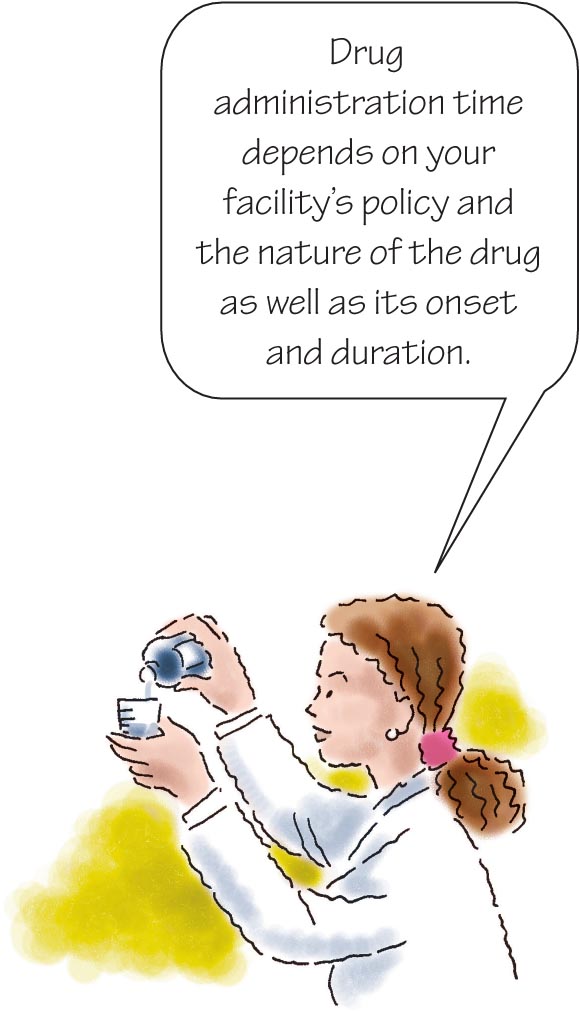After you determine that a drug order contains all the necessary information, you can begin to interpret it. Read on to find guidelines for dealing with illegible hand writing, timing drug administration, renewing drug orders, and discontinued drug orders. (See Say it in English.)
If any required information is missing or if the LIP's hand writing is illegible, check with the LIP and clarify the order before signing the transcription. Also ask the LIP for clarification if nonstand ard abbreviations are used.
When the order is clear, sign it and send a copy to the pharmacy where the drug will be dispensed according to your facility's policy.
Computerized provider order entry (CPOE)
CPOE is the computer system that allows direct entry of drug orders by the LIP. These drug orders are communicated over a secure computer network directly to other departments, such as the pharmacy. The pharmacist can review and then verify the drug order. The nurse must still check the accuracy on the MAR of the drug order before administering it to his/her patient. The CPOE system is designed to reduce drug errors. The CPOE is usually integrated with the electronic health record (EHR). The EHR is a digital version of the patient's paper chart.
Calibrating the clinical clock
Although the drug order sheet tells you when to give a drug, the actual administration time of a drug depends on three things:
your facility's policy (for drugs that are given a specific number of times per day).
the nature of the drug.
the drug's onset and duration of action.
Be sure to administer drugs within a half-hour or an hour of the times specified on the drug order sheet. After giving a drug, record the actual time of administration on the medication administration record.

Reevaluate, renew, reorder
Healthcare facilities also have policies for how often drug orders must be renewed. For example, opioids may need to be reordered every 24, 48, or 72 hours. This requirement allows health care professionals to reevaluate the patient's need for the drug and to adjust the dosage or frequency of administration, if necessary.
Remember that IV fluids—such as normal saline solution, dextrose and water, and total parenteral nutrition solutions—are considered drugs. Check all IV fluid orders carefully. Most healthcare facilities provide guidelines for the renewal of IV fluids as well as for other drugs.
If the LIP decides to discontinue a drug before the original order runs out, he/she must write a new order. These orders must also be precise.
For example, if an order reads discontinue K and the patient is receiving vitamin K and potassium chloride, you'll need to contact the LIP to clarify which medication he/she wants to discontinue.
Hand ling ambiguous drug orders
All too often, drug orders are unclear because of nonstand ard abbreviations, illegible hand writing, incorrect dosages, or missing information. It helps if hand written orders are neat, with drugs spelled correctly. (See Don't struggle with difficult orders.) CPOE systems can help to prevent some of these errors.
Rule #1: Bad input equals bad output.
Even if the LIP enters drug orders into the computer system, your interpretation skills are still extremely important. Although computers solve the problem of illegible hand writing, they can't correct human error. A computer will accept the wrong drug, the wrong dose, the wrong route, and the wrong frequency. Some newer computer systems can actually check the drug order against the patient's allergies, weight, and interactions with their other meds. Remember, some safeguards are programmed into computer systems to minimize errors, but it's still up to you to verify the orders.

Rule #2: Advocate appropriate administration.
Your responsibility in interpreting orders includes making sure that the ordered drug is an appropriate treatment. Your role as patient advocate comes into play in this situation. To make sure the drug you're asked to administer is appropriate:
Think critically; don't be timid about asking for clarification and justification.
Know the action of each drug you give, the purpose for which it's given, and its possible adverse effects.
Know your patient. Drugs should be used with caution in very young or very old patients as well as those who are pregnant or who have known kidney or liver disease, a compromised immune system, or diabetes.
If a drug order seems questionable, use all available resources to check it. For example, ask the LIP, the pharmacist, and your colleagues and refer to a drug hand book.
Always check the six “rights” before giving a drug. (See Right on target.)
Check and recheck all your drug calculations.
Never administer a drug that's improperly labelled or missing a label or that you personally didn't draw from a vial.
Never use open or unmarked IV solution bags.
![]() Memory Jogger
Memory Jogger
Repetition is key!
Use repetition to remember your responsibilities when it comes to drug administration. As you prepare to administer each drug, think of the actions you must take. To remember the steps in sequence, think of the phrase “Until Clear, Ask Many Times”:
Understand the drug and how it works.
Clarify the drug order as needed.
Administer the drug.
Monitor the patient for therapeutic response to the drug and for adverse effects.
Teach the patient about the drug as needed.



The following are examples of poorly written drug orders that need to be clarified by the LIP who wrote them. See if you can find the errors.

What?
K 40 mEq I.V. daily—It's unclear what drug is being ordered. Is it vitamin K or potassium chloride (KCl)? If it's KCl, remember that this electrolyte must be diluted in a large volume of IV fluid before administration.
How?
Digoxin 0.25 mg daily—The administration route is missing. Digoxin may be given orally as a pill or elixir or may be given IV.
When?
Nifedipine 10 mg P.O.—The frequency of administration is missing. Nifedipine can be given in a single dose for hypertension, or it can be given on another schedule as a maintenance drug. In the latter case, it's usually given orally.